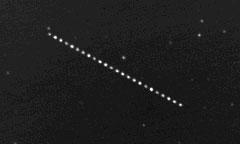
Using the SoTIE 14-inch telescope remotely, Gianluca Masi and Franco Mallia made this short animation from 24 exposures (5 seconds each) every 32 seconds from 3:11:09 to 3:23:42 Universal Time on March 18, 2004. In this time, the object moved 4 arcminutes. Notice the varying brightness as 2004 FH rotates.
Courtesy Gianluca Masi.
Right on schedule, asteroid 2004 FH made its dramatic pass about 42,700 kilometers (26,500 miles) above the Earth's surface on March 18, 2004, at 22:08 Universal Time. This is Earth's closest known encounter with a small solar-system body if you don't count objects that have actually entered the atmosphere. The object is believed to be about 30 meters (100 feet) across.
Just 10 hours before the flyby, Grant Christie of Auckland Observatory, New Zealand, detected periodic brightness fluctuations (amplitude 0.9 magnitude) in CCD images taken during a 17-minute interval. These suggest that 2004 FH rotates about once every 90 seconds, as reported on International Astronomical Union Circular 8310.
On Siding Spring Mountain, Australia, Robert McNaught and Gordon Garradd observed the flyby visually, three hours before closest approach, using a 5-inch (12.5-centimeter) refractor. "It was then magnitude 11 and moving about 10 arcseconds per second! The motion at 80x was quite obvious in real time," McNaught told members of the Minor Planet Mailing List.
Meanwhile, due to a power failure, astronomers at the giant Arecibo radio telescope in Puerto Rico were unable to make the radar observations they'd planned.
Using the remote imaging capabilities of SoTIE (Southern Telescopes in Education) at Las Campanas, Chile, Gianluca Masi and Franco Mallia of Campo Catino Astronomical Observatory, Italy, were able to record a brief movie of the event shortly before the closest approach. "Because of bad weather, we were going to miss the event here in Italy," said Masi. "However, our Web interface made the experience almost like we were right there at the telescope, collecting the data on site."
Not only is the flyby of 2004 FH the closest known pass of a solar system object, but the encounter was discovered with the Lincoln Near-Earth Asteroid Research (LINEAR) robotic telescope in New Mexico shortly before closest approach. The next three record encounters, listed below, were only detected after closest approach.
| Closest Recorded Asteroid Flybys | ||
| Designation | Fraction of Earth-Moon Distance (384,000 km) | Date |
| 2004 FH | 0.13 | Mar. 18, 2004 |
| 2003 SQ222 | 0.22 | Sept. 27, 2003 |
| 1994 XM1 | 0.28 | Dec. 9, 1994 |
| 2002 XV90 | 0.30 | Dec. 11, 2002 |
 0
0
Comments
You must be logged in to post a comment.